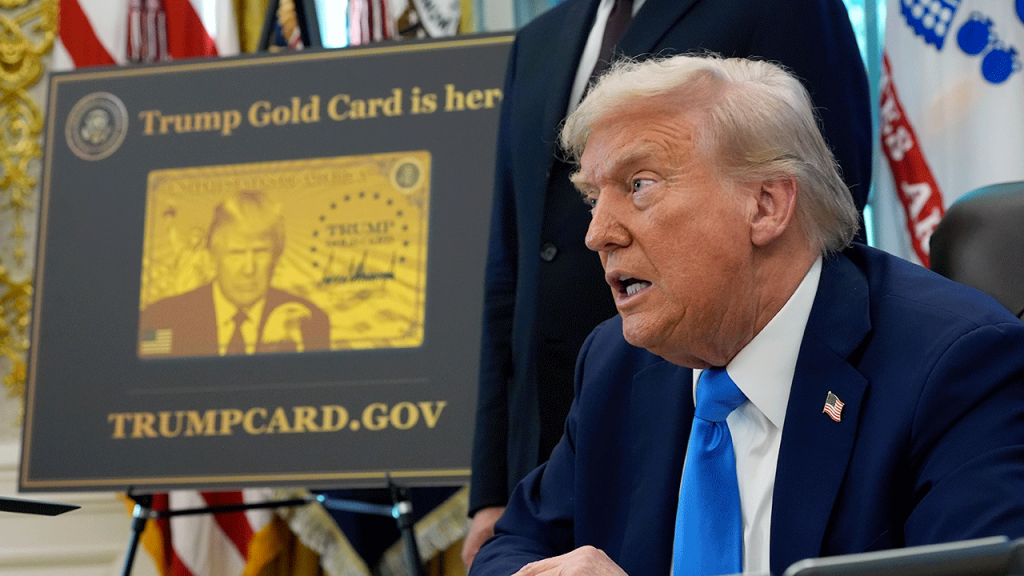Trump Unveils “Gold Card” Immigration Program with $1 Million Price Tag
President Donald Trump has launched a new immigration initiative called the “Trump Gold Card,” offering wealthy individuals a fast track to U.S. residency for $1 million. Announced via Truth Social, this program features a distinctively designed card emblazoned with Trump’s portrait, the Statue of Liberty, and the American flag against a gold background. The president framed this initiative as a solution to America’s immigration challenges, stating, “For far too long, we have had millions of Illegal Aliens pouring into our Country, and our Immigration System was broken. It is beyond time that the American People, and American Taxpayers, are benefitting from our LEGAL Immigration System.” The program aims to generate significant revenue, with Trump projecting it will bring in “well over $100 Billion Dollars very quickly” – funds he claims will go toward reducing taxes, supporting growth projects, and paying down national debt.
The Trump Gold Card program operates through an official government website (trumpcard.gov) where interested parties can apply for what the site describes as “exclusive privileges.” The application process begins with document submission and payment of a nonrefundable processing fee, followed by an accelerated investigation conducted by U.S. Citizenship and Immigration Services. Officials will perform thorough background checks and vetting procedures before approving applicants. Successful applicants receive lawful permanent resident status as EB-1 or EB-2 visa holders, with their Gold Card granting them residency rights across all fifty states and U.S. territories. The website does caution that card status can be revoked for national security concerns or other significant risks.
While individuals can currently purchase the Gold Card for $1 million, the program will eventually expand to include corporate applications at a higher price point of $2 million. This tiered approach reflects the administration’s strategy to maximize revenue generation while creating different entry points for affluent immigrants and businesses seeking expedited access to U.S. residency. The corporate option suggests an attempt to appeal to international businesses looking to establish a stronger presence in the American market through executive relocation or investment opportunities, further diversifying the program’s potential applicant pool and revenue streams.
The administration has also announced plans to introduce a “Trump Platinum Card” as a companion program targeting wealthy international travelers. Unlike the Gold Card’s permanent residency offering, the Platinum Card will allow holders to stay in the United States for up to 270 days per year without subjecting their non-U.S. income to American taxation. This program appears designed to replace traditional travel visas for wealthy visitors, creating a premium tier of entry permission for high-net-worth individuals. Although not yet available, the administration is encouraging interested parties to join a waitlist, emphasizing that applications will be processed in the order received once the program launches.
This initiative bears resemblance to “golden visa” programs implemented in various countries around the world, which offer residency or citizenship in exchange for significant investment. Such programs have proven popular among wealthy individuals seeking mobility, security, or tax advantages, but have also faced criticism for potentially enabling money laundering or creating immigration pathways available only to the ultra-wealthy. The Trump administration’s approach differs primarily in its direct fee structure rather than requiring investment in specific sectors of the economy, as many international programs do. The explicit branding with the president’s name and the direct government revenue generation aspect also distinguish it from typical investment-based immigration programs.
The introduction of the Trump Gold Card comes amid ongoing national debates about immigration policy and border security. By framing the program as beneficial to American taxpayers and the economy, the administration appears to be attempting to reconcile restrictive immigration rhetoric with opportunities for wealthy immigrants. The program’s focus on generating revenue while maintaining strict vetting processes reflects a transactional approach to immigration that prioritizes economic contribution above other considerations. As implementation begins, questions remain about how many applicants will pursue this expensive pathway to residency, how the generated funds will actually be allocated, and how this program will fit into broader immigration reform efforts in the United States.










